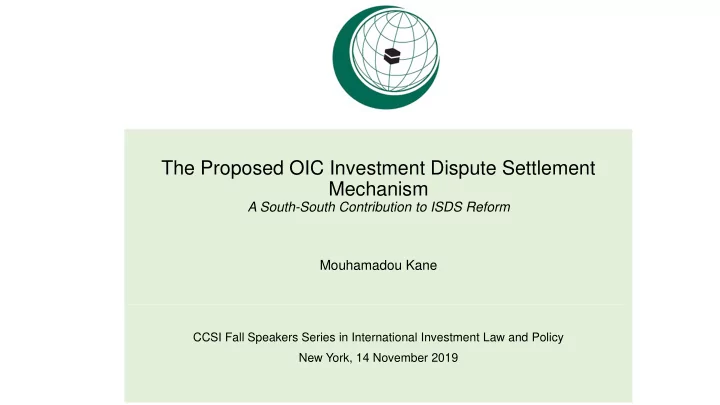

The Proposed OIC Investment Dispute Settlement Mechanism A South-South Contribution to ISDS Reform Mouhamadou Kane CCSI Fall Speakers Series in International Investment Law and Policy New York, 14 November 2019
Three (3) talking points 1. Demystifying the OIC Investment Treaty! 2. What are the concerns of the developing south about current ISDS systems? 3. How is the ongoing reform of the OIC investment dispute settlement system trying to address these concerns?
Seven (7) facts about the treaty 1. 1. Ado dopted in 1981 2. 2. En Entered into for orce in 1988 3. 3. Signed by 36 Member States 4. 4. Ra Ratif ifie ied by 29 Member States 5. 5. Refers to ISD ISDS for or di dispute se settle lement (ar (art.17), ), “until a permanent organ is established”; 6. 6. Fir First t IS ISDS case und under Art.1 rt.17: Al-Warraq vs. Indonesia , 2012; 7. 7. Mul ultip ipli licatio ion of of cases si since 2012: : 6 to 8 new cases since 2012
Three (3) OIC policy decisions about need to reform Article 17 1. Policy recommendation during OIC-IPA Forum in 2016 in Riyadh 2. CFM Resolution No. E-43/E (Tashkent, 2016) 3. CFM Economic Resolution (Abu Dhabi, 2019)
Ten (10) key concerns of the developing south • Regulatory chill and constraints on right to regulate Sovereignty • Impact on development of domestic judicial institutions and domestic rule of law • Independence and impartiality • Inconsistency • Lack of appellate mechanism Legitimacy • Frivolous claims • Third-party funding • Impacts on non-parties to the dispute • Costs of Arbitration Capacity • Capacity to handle sophisticated claims
Responses to sovereignty, legitimacy and capacity concerns in the OIC system 1. Design principles 2. Dispute Settlement Architecture 3. Investor-State Dispute Settlement Mechanism 4. State-State Dispute Settlement Mechanism 5. Legal Assistance Facility (LAF) 6. Other concerns (third-party funding and frivolous claims)
(1) Design principles 1. Limiting access to ISDS 2. Institutionalizing Dispute Prevention 3. Designing the system in line with the following key principles ▪ Subsidiarity ▪ Transparency ▪ Participation (third parties???) ▪ Accountability
(2) Dispute Settlement Architecture Policy Forum Ministerial Level Dispute Prevention State-State DSO Mechanism Two-Step Adjudication First Instance Panel Appelate Committee Mechanism DSO Secretariat
(3) Investor-state dispute settlement mechanism
(4) State-state dispute settlement mechanism
(5) Legal Assistance Facility 1. Proposal for an independent organ to be established within one of the OIC economic organizations; 2. Mandate will be to provide legal assistance to Member States to respond to disputes. Mandate may also extend to providing capacity building; 3. LAF shall report annually to the Policy Forum
(6) Third-Party Funding and Frivolous Claims 1. Matters not be regulated in the Investment Dispute Settlement Protocol; 2. Matters to be addressed in the Rules and Regulations of the Dispute Settlement Organ; 3. Will take benefit of outcome of ongoing discussions at UNCITRAL
Summary of reform proposals Concerns about ISDS OIC Reform Proposals • Sovereignty Establishment of the Policy Forum which shall have mandate to interpret substantive provisions of the OIC treaty and thereby prevent regulatory chill • Introduction of the requirement to exhaust local remedies, thereby reinforcing domestic judicial institutions and domestic rule of law • Legitimacy Establishment of a permanent dispute settlement mechanism to address consistency, independence and impartiality issues • Introduction of an appeal mechanism • ISDS limited to denial of justice claims • State-state dispute settlement introduced as a filter before 2-step adjudication mechanism • Introduction of a right of participation of third parties interested in disputes • Regulation of TPF and introduction of mechanisms to prevent frivolous claims • Capacity Establishment of an advisory center to assist Member States in facing investment disputes
THANK YOU NEXT STEPS
Recommend
More recommend